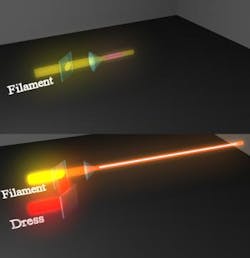| A schematic diagram shows a primary central femtosecond-laser beam propagating alone (top) and with a dress beam (bottom). The dress beam prevents the rapid dissipation of the central beam, extending the length of the resulting current-guiding filament produced in the air. (Image: UA) |
While femtosecond-laser-beam filamentaton in the atmosphere has long been pursued as a way to guide lightning (or simply trigger lightning strikes), researchers at the University of Arizona (UA; Tucson, AZ) and the University of Central Florida (UCF; Orlando, FL) have developed a way to send high-energy femtosecond-laser beams through the atmosphere much farther than was previously possible, increasing the potential range for guiding lightning.1
Filaments produced previous by femtosecond-laser setups would essentially disappear over distances greater than a few meters at best when focused tightly, due to diffraction. In the new approach, the primary, high-intensity laser beam is embedded within a second beam of lower intensity. As the primary beam travels through the air, the second beam -- called the dress beam -- acts as a distributed energy reservoir, refueling and sustaining the primary beam over much greater distances than were previously achievable.
Could reach 50 m or more
In the lab, the researchers were able to extend the range of filament lasers from about 25 cm to almost 2 m. Simulations performed by Matthew Mills at the University of Central Florida have shown that by scaling the new laser technology to atmospheric proportions, the range of the laser filaments could reach 50 m or more.
In addition to guiding lightning, the technique could be used in remote sensing, attosecond physics and spectroscopy, and channelling microwaves. The development of the new technology was supported by a five-year, $7.5 million U.S. Department of Defense grant.
Source: http://uanews.org/story/new-laser-technology-developed-by-ua-could-divert-lightning-strikes
REFERENCE:
1. Maik Scheller et al., Nature Photonics 8 (2014); doi: 10.1038/nphoton.2014.47
